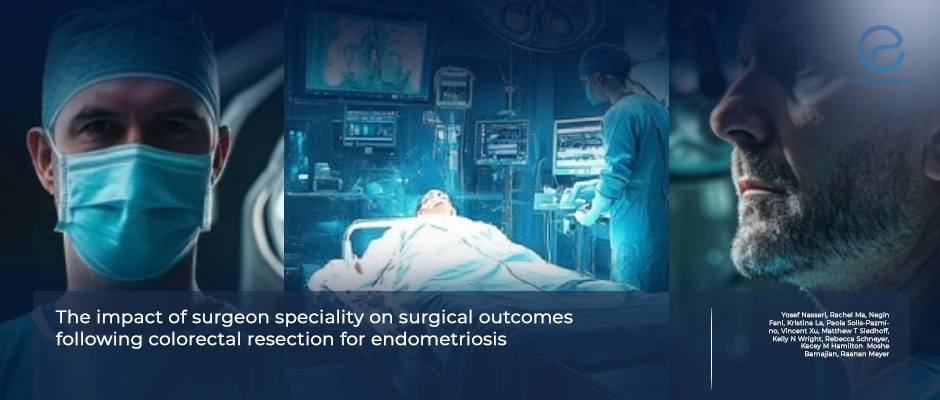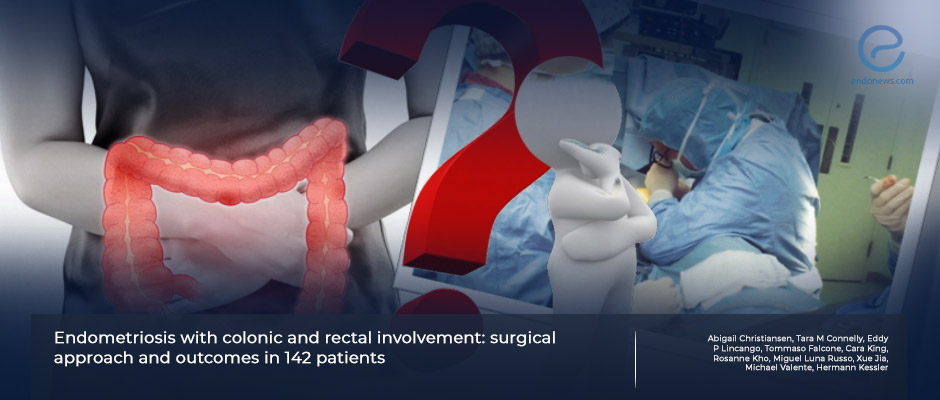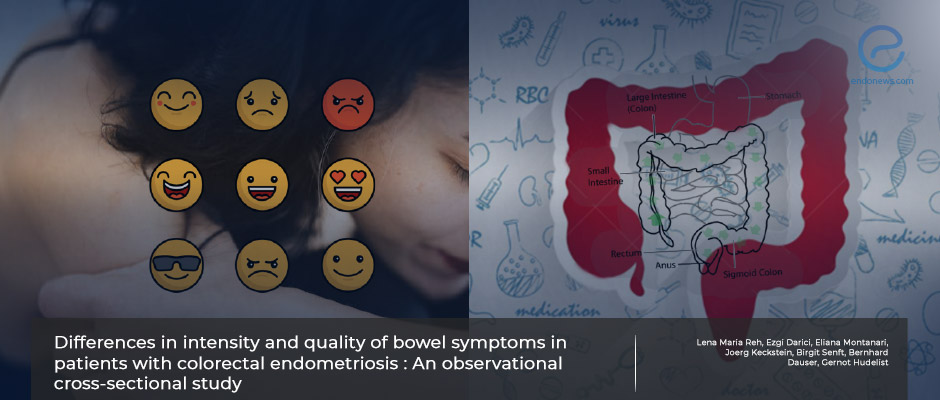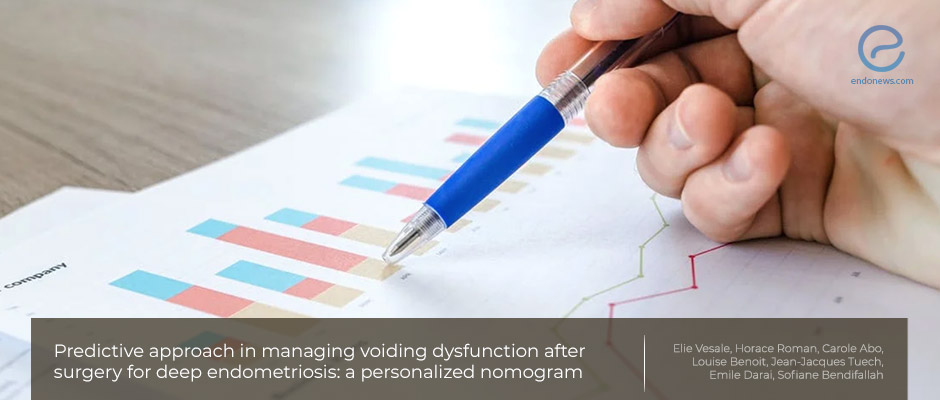The Role of Surgeon Specialty in Colorectal Resection Outcomes for Women with Endometriosis
When endometriosis invade the tissues, including the bowel wall by more than 5 mm, it is termed deep infiltrating endometriosis. Patients with bowel involvement typically experience symptoms such as constipation, diarrhea, tenesmus, and rectal bleeding. Surgical intervention is often the…
Key Points Lay SummaryRobot-assisted laparoscopy for deep infiltrating endometriosis of bowel
Deep infiltrating endometriosis is characterized by lesions larger than 5 mm that penetrate the peritoneum or invade the muscular layer of adjacent organs, affecting over 20% of women with endometriosis. Bowel involvement occurs in 5-12% of cases and may present with…
Key Points Lay SummaryCurrent practice in robotic surgery for deep-infiltrating endometriosis
Today, surgical excision of endometriotic lesions is the only cytoreductive procedure for managing endometriosis. Hormonal treatment may partly relieve the symptoms, but it suppresses rather than cytoreduction of the disease. Minimally invasive surgery is usually the most preferred method due…
Key Points Lay SummaryFertility outcomes after discoid excision for colorectal endometriosis.
Colorectal endometriosis is one of the most severe forms of deep endometriosis, composing 85% of all bowel lesions. Radical treatment is segmental resection of the bowels, which can cause postoperative severe complications such as rectovaginal fistula and voiding dysfunctions that negatively…
Key Points Lay SummaryThe type of surgical approach compared to complications and recurrence for colorectal endometriosis
Women with endometriosis may have extension and infiltration of the intestine, called "colorectal endometriosis, in up to 12%. The main symptoms are alterations in bowel habits, pelvic pain, and/or infertility. The gold standard management option for colorectal endometriosis is surgical…
Key Points Lay SummaryComparison of two different surgical approach to deep colorectal endometriosis in terms of postoperative outcomes.
Deep colorectal endometriosis affects one-fifth of women with endometriosis, which is commonly associated with more pelvic pain and severe gastrointestinal symptoms. Three surgical approaches for deep colorectal endometriosis are segmental colorectal resection, full-thickness discoid resection, and shaving operation. Choosing the…
Key Points Lay SummaryDoes Endometriosis Surgery Increase the Rate of Pregnancy?
Surgery to treat colorectal endometriosis leads to a high rate of pregnancy following the operation, found a new study published in the Journal of Minimally Invasive Gynecology. The authors of the study said, “studies with a high level of evidence…
Key Points Lay SummaryPostoperative pregnancy outcomes in women with deep infiltrating endometriosis
Subperitoneal invasion of endometriotic lesions exceeding 5 mm in depth is named "deep infiltrating endometriosis' and can be located on uterosacral ligaments, in the intestine, vagina, bladder, and ureter. Women with deep infiltrating endometriosis suffer from pelvic pain and infertility most…
Key Points Lay SummaryGastrointestinal symptoms in colorectal deep endometriosis
The colon, particularly the recto-sigmoid is the most commonly involved area in deep endometriosis. These patients suffer from gastrointestinal symptoms almost as much as pelvic pain symptoms the most common being reported as frequent and painful defecation. Gastrointestinal symptoms may…
Key Points Lay SummaryObstetric Outcomes of Pre-pregnancy Endometriosis Surgery
Endometriosis may be associated with poor pregnancy outcomes, including placenta praevia, preterm birth, premature prelabour rupture of membranes, obstetric hemorrhage, gestational hypertensive disorders, fetal growth restriction, and perinatal death. Some authors have attempted to demonstrate a causal relationship between endometriosis…
Key Points Lay SummaryHow beneficial is colorectal surgery for patients with deep endometriosis?
In cases of deep endometriosis, which causes more severe pain and gastrointestinal symptoms, the patient's quality of life and fertility outcomes are negatively affected. Surgical intervention is thought to be the optimal treatment method in colorectal deep endometriosis cases, however,…
Key Points Lay SummaryLife quality improves after colorectal endometriosis operation even when the gastrointestinal symptoms persist
Colorectal endometriosis represents a catastrophic picture for patients, and the treatment mostly requires difficult operative techniques. The life quality improvement ratios are important before deciding on an operation. In the study conducted by Horace Roman et al, the life quality…
Key Points Lay SummaryA comparison of symptomatology and histopathologic features in surgically resected colorectal endometriosis
Dr. Tschan and associates from Feldrich Academic Teaching Hospital, Austria published their retrospective research on patients requiring colorectal surgical resection for endometriosis in European Journal of Medical Research. Bowel endometriosis requiring colorectal surgical resection causes important morbidity. The rectum and…
Key Points Lay SummaryPredictors of voiding dysfunction after surgery for deep endometriosis
While surgery for deep endometriosis provides relief and improves the quality of life in symptomatic patients for whom medical therapy has limited effect, it may also create postoperative lower urinary tract dysfunction. Moreover, postoperative voiding dysfunction could affect the quality…
Key Points Lay SummaryWhich surgical approach for bowel endometriosis?
A group of researchers from Spain, led by Dr. Alicia Hernández Gutiérrez, conducted a retrospective study to compare postoperative complications and recurrence of three surgical techniques: segmental bowel resection (group I), discoid excision (group II), and rectal nodule shaving (group…
Key Points Lay SummaryThe postoperative functional outcomes of deep infiltrating endometriosis
Rectosigmoid endometriosis is defined as the infiltration of the bowel wall with the endometrial-like glands and stroma, reaching at least the muscular layer. The most commonly involved sites are the rectum and sigmoid colon. For the management of deep infiltrating…
Key Points Lay SummaryReduced pain and increased fertiliy rates after surgery for colorectal endometriosis
This prospective cohort study which recently published in AOGS by Hudelist et al. from Oslo University, Norway is about their one hundred thirty-four laparoscopic operations of DIE cases performed between 2011 and 2016, in a tertiary center in Oslo. The…
Key Points Lay SummaryStenoses in the colorectal anastomose sites after DIE surgery
Deep infiltrating endometriosis (DIE) is a particular form of endometriosis that penetrates at least 5 mm under the peritoneal surface. DIE is primarily located in the rectosigmoid junction and the rectum with an incidence of 70% and 90%, respectively. The…
Key Points Lay SummaryA Way to Better Diagnose Colorectal Endometriosis
Combining magnetic resonance imaging (MRI) with computed tomography-based virtual colonoscopy (CTC) can make the assessment of colorectal endometriosis more accurate. This is important because it can help doctors plan the surgery better and inform their patients. In order to evaluate…
Key Points Lay SummaryIntestinal Endometriosis and Colorectal Cancer versus T4 Colorectal Cancer
Ishii et al. recently published a paper titled “Intestinal endometriosis combined with colorectal cancer: a case series” in the Journal of Medical Case Reports. This case report follows 7 Japanese women who have intestinal endometriosis and colorectal cancer. These women…
Key Points Lay SummaryEffects of osteopathic manipulative therapy in patients with colorectal endometriosis
Alternative treatments have been used for colorectal endometriosis, between them Chinese medicine, acupuncture and more recently osteopathic manipulative therapy. The osteopathic manipulative therapy has been shown to reduce the chronic pain working on muscular contractions due to vicious analgesic positions.…
Key Points Lay SummaryHow rats can help improve colon endometriosis treatment in humans
Colorectal endometriosis forms about 3–37% of all deep infiltrating endometriosis (DIE) cases. DIE is a highly invasive type of endometriosis, occurs when ovarian endometriomas overgrow and rupture, releasing their contents into the abdominal and pelvic cavity, resulting in the formation…
Key Points Lay Summary
 By Hale Goksever Celik
By Hale Goksever Celik

 By Selma Oransay
By Selma Oransay





 By Özge Özkaya
By Özge Özkaya


 By Eylül GÜN
By Eylül GÜN



 By Bahar Yuksel
By Bahar Yuksel

 By Nasuhi Engin Aydin
By Nasuhi Engin Aydin


 By Irem Onur
By Irem Onur





 By Kasthuri Nair
By Kasthuri Nair

 By Laura Ardighieri
By Laura Ardighieri

 By Demet Candaş Green
By Demet Candaş Green